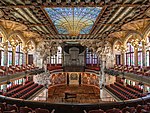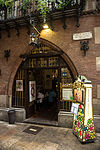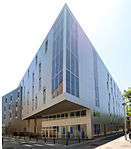Caelis
European restaurant stubsMichelin Guide starred restaurants in SpainRestaurants in BarcelonaSpanish cuisine stubs

Caelis is a Michelin-starred restaurant in Barcelona, Spain. In 2002, Toulouse chef Romain Fornell took over the Diana restaurant at the El Palace Hotel and renamed it Caelis in 2004. It received its Michelin star the next year. The restaurant was closed from 2009 to 2011, when the hotel underwent a major renovation. Caelis moved to the Hotel Ohla in 2017.
Excerpt from the Wikipedia article Caelis (License: CC BY-SA 3.0, Authors, Images).Caelis
Via Laietana, Barcelona
Geographical coordinates (GPS) Address Website Nearby Places Show on map
Geographical coordinates (GPS)
| Latitude | Longitude |
|---|---|
| N 41.387055555556 ° | E 2.1743333333333 ° |
Address
Ohla Hotel
Via Laietana 61
08001 Barcelona (Ciutat Vella)
Catalonia, Spain
Open on Google Maps










